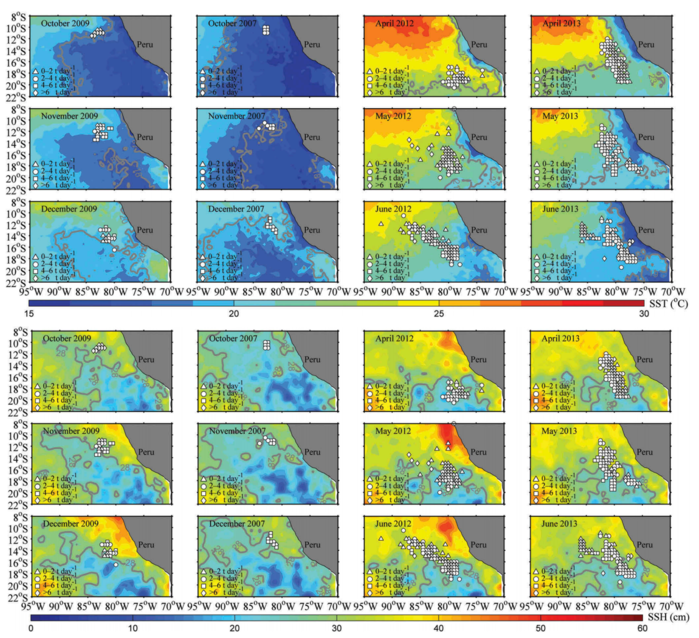| Date |
February 15, 2019
|
|---|---|
| Content Type |
User Story
|

|
|
| Data Applications |
Fisheries & Aquaculture
|
The jumbo flying squid (Dosidicus gigas), also known as the Humbolt squid, is an economically important fisheries species in the Eastern Pacific, currently accounting for approximately one third of the world's squid landings.

Understanding the impacts of climate and environmental variability on this commercial marine species is important for fisheries operations and fisheries management efforts. In order to determine the impact of climatic and oceanographic conditions on the spatial distribution of the jumbo flying squid fishery in the Southeast Pacific Ocean, Yu et al., (2017) mapped sea surface temperature and sea surface height data from NOAA OceanWatch Central Pacific node and chlorophyll-a data from the Asia-Pacific Data Research Center at the University of Hawaii with commercial fisheries data.

The researchers analyzed the data to identify the environmental conditions that were most favorable for the squids and use this information to explain observed movements of the fishing ground.
References and Related Reading
- Alabia, I. D., S. I. Saitoh, T. Hirawake, H. Igarashi, Y. Ishikawa, N. Usui, M. Kamachi, T. Awaji, and M. Seito. 2016. Elucidating the Potential Squid Habitat Responses in the Central North Pacific to the Recent ENSO Flavors. Hydrobiologia 772 (1): 215227.
- Arkhipkin, A.I., Rodhouse, P.G.K., Pierce, G.J., Sauer, W., Sakai, M., Allcock, L., Arguelles, J., Bower, J.R., Castillo, G., Ceriola, L., Chen,C-S., Chen, X., Diaz-Santana, M., Downey,N., González, A.F., Granados Amores, J., Green, C.P., Guerra, A., Hendrickson, L.C., Ibáñez, C., Ito, K., Jereb, P., Kato, Y., Katugin, O.N., Kawano, M., Kidokoro, H., Kulik, V.V., Laptikhovsky, V.V., Lipinski, M.R., Liu, B., Mariátegui, L., Marin, W., Medina, A., Miki, K., Miyahara, K., Moltschaniwskyj, N., Moustahfid, H., Nabhitabhata, J., Nanjo, N., Nigmatullin, Ch.M., Ohtani, T., Pecl, G., Perez, J.A.A., Piatkowski, U., Saikliang, P.j, Salinas-Zavala, C.A., Steer, M., Tian, Y., Ueta, Y., Vijai, D., Wakabayashi, T., Yamaguchi, T., Yamashiro, C., Yamashita, N. and Zeidberg, L.D. 2015. World squid fisheries. Reviews in Fisheries Science and Aquaculture 23: 92-252.
- Yu, W., Q. Yi, X. Chen, Y. Chen. 2017. Climate-driven latitudinal shift in fishing ground of jumbo flying squid (Dosidicus gigas) in the Southeast Pacific Ocean off Peru. International Journal of Remote Sensing 38 (12): 3531-3550.
